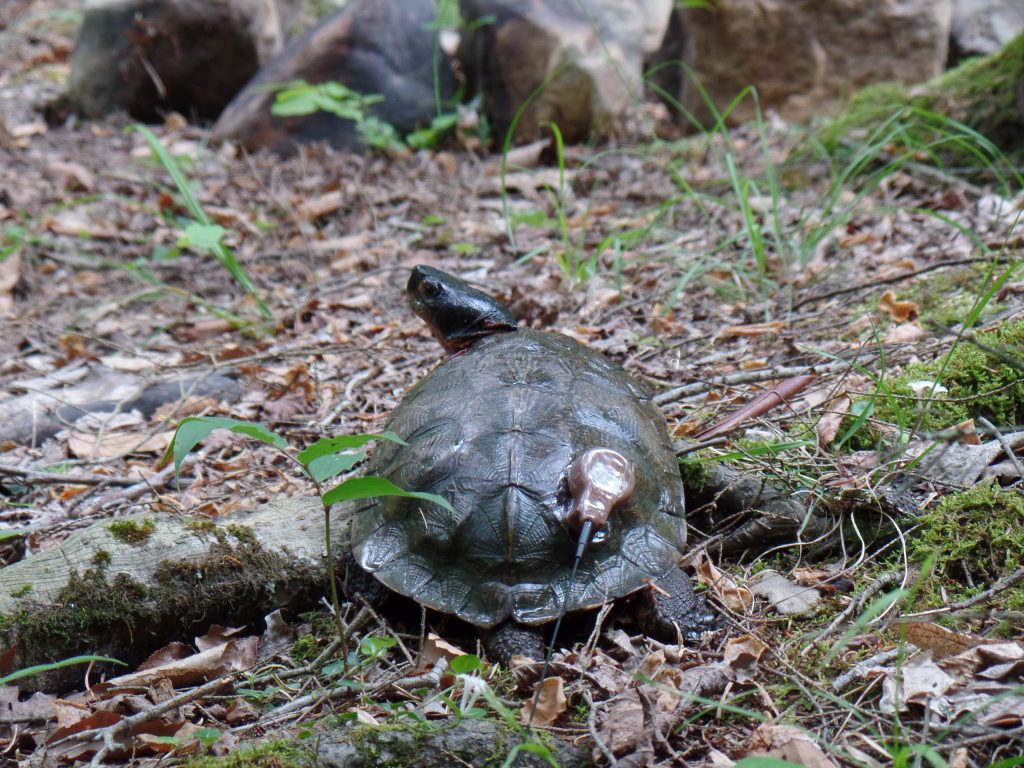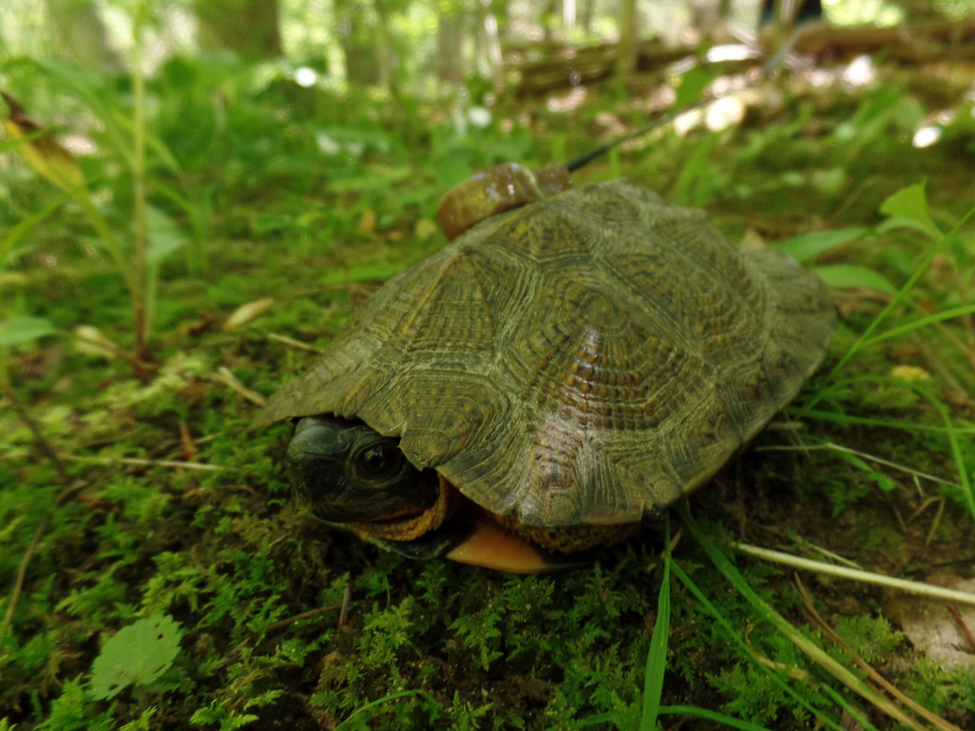
Wood Turtle found along Shaver’s Creek. Photo by Carli Dinsmore
Through the splintered pickets of an aged locust fence in the waning light of a mellow June day, a turtle emerges from a thicket of smartweed, lumbering towards the gravel shoulder of an unpaved forest road. She appears with a suddenness which belies her cumbersome form — the broad sculpted shell chipped and worn; each scute etched with a pyramidal relief as though delicately carved into dusky wood. Purposefully, she climbs the macadam, orange, scaly legs deliberate and unflagging. She scents the ground, pausing to scrape the surface of the slope from time to time as she ascends. The painstaking manner of the search evinces the significance of what she seeks. The culmination of a year’s labors — perhaps the last of a lifetime. She seeks a citadel, a refuge in which to relinquish her burden into the womb of the earth. It is here, far from her riparian home, that she will prepare her nest.
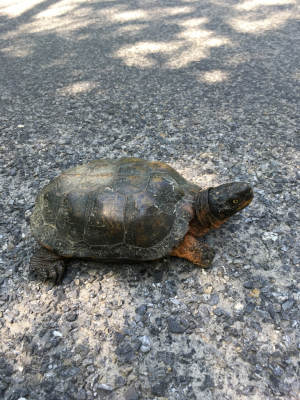
The Wood Turtle, Glyptemys insculpta, makes its home in the mossy, sun-dappled forest interior where streams course loquaciously and the song of the wood thrush tumbles through the understory of alders and witch hazel. This ancient reptile is bound by an unseen filament to the stony-bottomed perennial streams and rivers of Pennsylvania’s forests and farmlands. Each spring, in waters just beginning to free themselves of the icy bonds of winter, Wood Turtles begin to rouse from their hibernaculum, where they have spent the frigid winter months safe from freezing in the sinuous waters. The ectothermic physiology is ruled by an inextricable connection between metabolic rate and ambient temperature. This coupling of temperature and energy assimilation proves advantageous during weeks spent in subzero temperatures, wherein metabolism is reduced to a minimum. This means that Wood Turtles can subsist for long periods of time without eating, drinking or even breathing, completely submerged in the icy water.
Conversely, the cold-blooded nature of this shy sun-worshipper imposes restraints on many aspects of their life history, which is shaped by activity patterns and energy intake. With this slow and steady strategy, these animals grow gradually and are late to reach reproductive maturity — a milestone of 14–18 years; and while potentially long-lived, a Wood Turtle must first overcome low nest success and high juvenile mortality in order to reach adulthood. As a result, an adult turtle must reproduce numerous times over the course of many years in order to replace itself in the population. Disjunct populations of Wood Turtles, isolated by habitat fragmentation, are declining across their range from Nova Scotia in the north to Wisconsin, Minnesota and northern Indiana. Listed as endangered by the International Union for Conservation of Nature (IUCN), and designation as a State Wildlife Action Plan Priority Species in Pennsylvania, Wood Turtles are reliant on both healthy lotic water systems as well as un-fragmented upland forests. In addition, populations are at risk without high-quality nesting sites, a crucial component of their habitat and annual cycle. Water pollution, fragmentation by roadways and illegal collection all represent significant threats to Wood Turtle conservation.
As with most features of Wood Turtle behavior and ecology, they are slow to reproduce. Age and size thresholds must be attained before individuals become reproductively active, and females may not breed every year. Oviparous, or egg-laying, Wood Turtles provide no parental care once the clutch of eggs has been laid. Females begin searching for nesting sites in mid-May, and may be compelled to travel long distances, often crossing roads or active agricultural areas, in order to find suitable habitat. Well-drained sand or gravel soils with lots of sun exposure and little vegetation are ideal for digging the shallow depression in to which the malleable eggs are deposited. Nest selection is an assiduous and exacting process, constituting the only form of parental investment for the species. Females stage for days prior to nesting, wily and circumspect, often creating false nests to confound predators. After nearly three months of incubation, viable hatchlings will emerge and journey to the safety of their natal waterway.
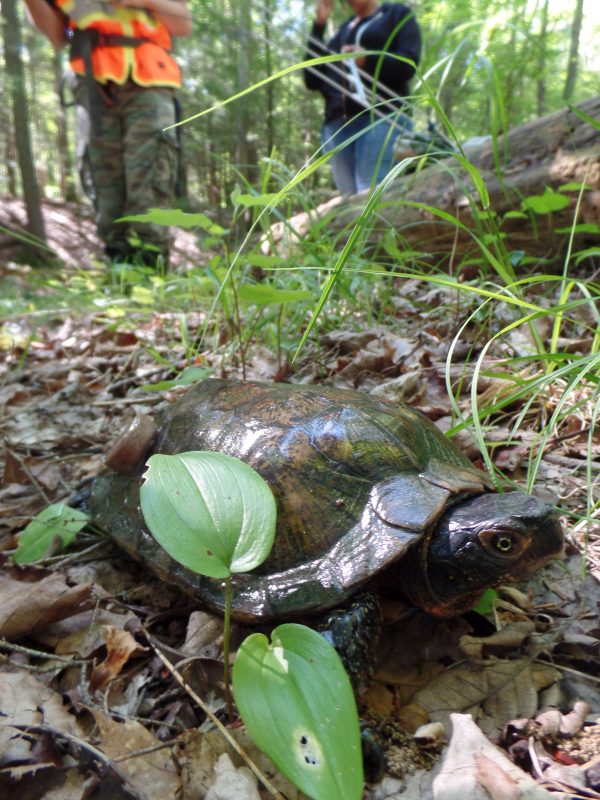 For tens of thousands of years, turtles have fascinated us, influencing our culture and appearing in our art and legends. The cryptic carapace and plastron of the shell — the yin and yang of one of the most bewildering morphologies of the vertebrate phylum — bone bound in keratin scales, fused to backbone and ribs. The only animal whose hip and shoulder girdle are within its ribcage; the sharp beak of the hooked head reflecting an evolutionary history little removed from a time when reptiles dominated the planet. The thoughtful and unhurried pace of life reveals an awe-inspiring poise and fortitude we revere and admire. With such a complex life cycle, dependent on multiple habitats and long-term survival, it is unsurprising that Wood Turtle populations are diminishing. This bashful muncher of mushrooms is a unique and invaluable part of Pennsylvania’s rich biodiversity. Conservation action is crucial to maintaining the species, and the multifarious web of plants and animals which constitute these vital ecosystems. Appropriate consideration with respect to land management practices can prevent mortality and preserve critical habitat.
For tens of thousands of years, turtles have fascinated us, influencing our culture and appearing in our art and legends. The cryptic carapace and plastron of the shell — the yin and yang of one of the most bewildering morphologies of the vertebrate phylum — bone bound in keratin scales, fused to backbone and ribs. The only animal whose hip and shoulder girdle are within its ribcage; the sharp beak of the hooked head reflecting an evolutionary history little removed from a time when reptiles dominated the planet. The thoughtful and unhurried pace of life reveals an awe-inspiring poise and fortitude we revere and admire. With such a complex life cycle, dependent on multiple habitats and long-term survival, it is unsurprising that Wood Turtle populations are diminishing. This bashful muncher of mushrooms is a unique and invaluable part of Pennsylvania’s rich biodiversity. Conservation action is crucial to maintaining the species, and the multifarious web of plants and animals which constitute these vital ecosystems. Appropriate consideration with respect to land management practices can prevent mortality and preserve critical habitat.
All of the natural world is comprised of intricate networks of exchange held in a tenuous balance through the unending flux of concession and advantage. It is the same old story of determination, survival and conquest which continues to play out at every level across taxa and time. The sun smolders just below the horizon, effusing the light with an ethereal quality, while the Wood Turtle works patiently. She knows just how carefully it must be done, assured by a wisdom which echoes back through 200 million years of evolution. The white fibrous eggs spill out, one after the other, tumbling into their shallow sanctuary. As though in concert with the close of day, the final egg drops. Darkness seeps from the forest edge, blanketing the gravel road; but a new light burns from within the nest — the muted glow of something yet to come. She shifts and begins to dig, concealing the opalescent orbs under a layer of earth, the final aegis she has to offer these offspring she will never see. Is it tenderness, how she arranges the soil just so? She turns to leave them, a handful of shining pennies tossed into a cosmic well, a wish planted in the ground. As she plods across the road back towards the forest, the ground resonates with the vibration of an approaching vehicle and the rain begins to fall.
For more information on Wood Turtles please visit the Pennsylvania Amphibian and Reptile Survey (PARS) or contact Shaver’s Creek.
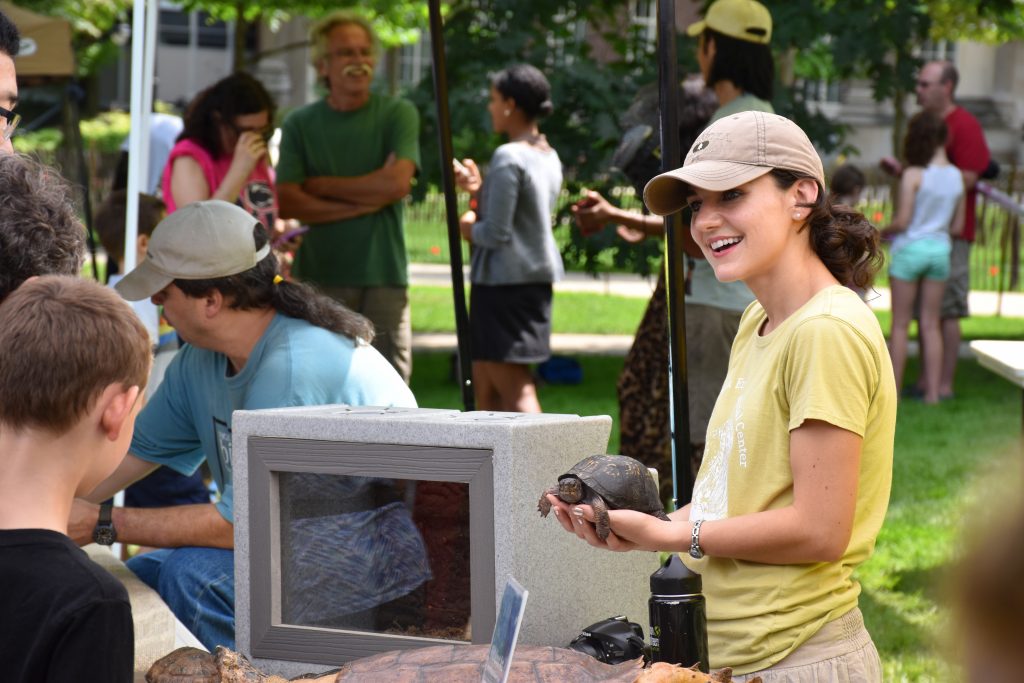
Carli Dinsmore is working with group of students from Penn States Ecology and Wildlife and Fisheries Science, whose programs have been monitoring a lively population of Wood Turtles in the riparian forests surrounding Shaver’s Creek throughout the spring and summer of 2017. Insight into the health, size and range of this population, and establishing long-term monitoring sites are essential for the preservation of this unique species.
Originally printed in The Valley newsletter.

